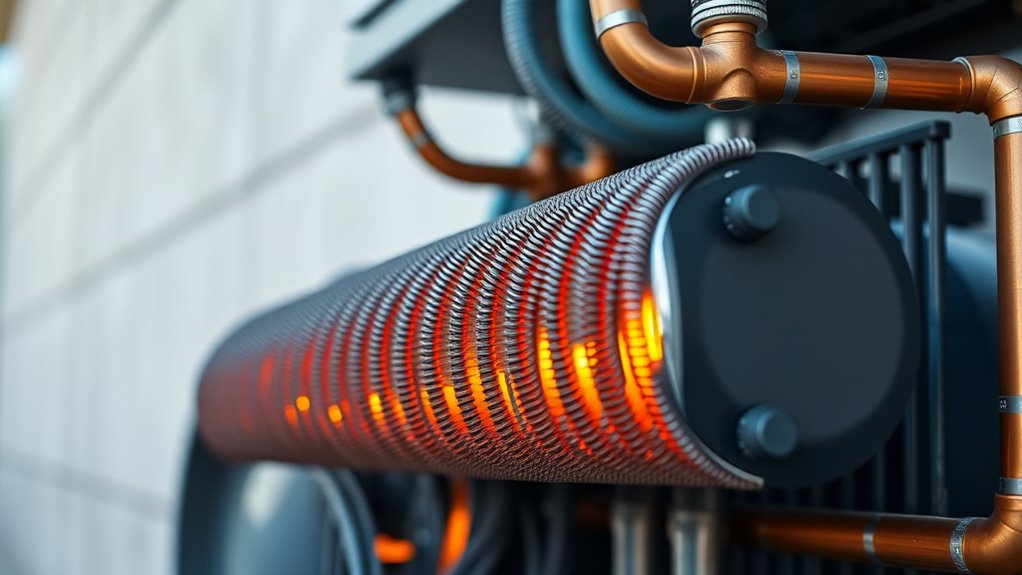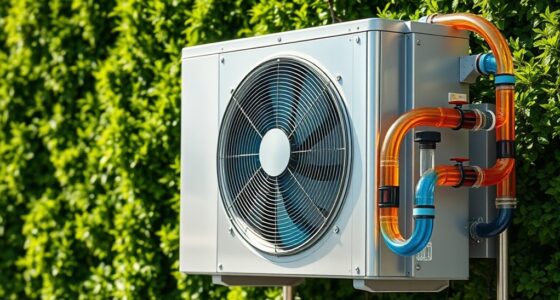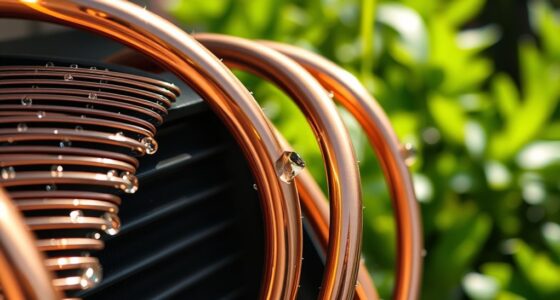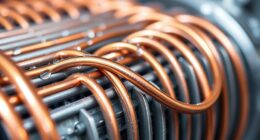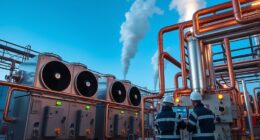Understanding how heat transfers in heat pumps involves exploring conduction, convection, and radiation, which move heat between environments. The refrigerant absorbs heat during evaporation at low pressure, then is compressed to release heat during condensation. Pressure controls boiling points, enabling phase changes that transfer thermal energy efficiently. The compressor boosts refrigerant temperature, making heat transfer against natural gradients possible. Keep exploring to discover how thermodynamics and system design optimize heat pump performance.
Key Takeaways
- Heat pumps transfer heat by absorbing it during refrigerant evaporation at low pressure and releasing it during condensation at high pressure.
- The refrigeration cycle relies on phase changes of refrigerants, utilizing latent heat to efficiently transfer thermal energy.
- Heat transfer mechanisms include conduction within system components, convection with circulating fluids, and radiation across gaps.
- The compressor increases refrigerant pressure and temperature, enabling heat transfer from colder outside air to warmer indoor spaces.
- Thermodynamic principles, such as pressure-temperature relationships and Carnot efficiency limits, govern the heat transfer process.
Basic Principles of Thermodynamics in Heat Pumps
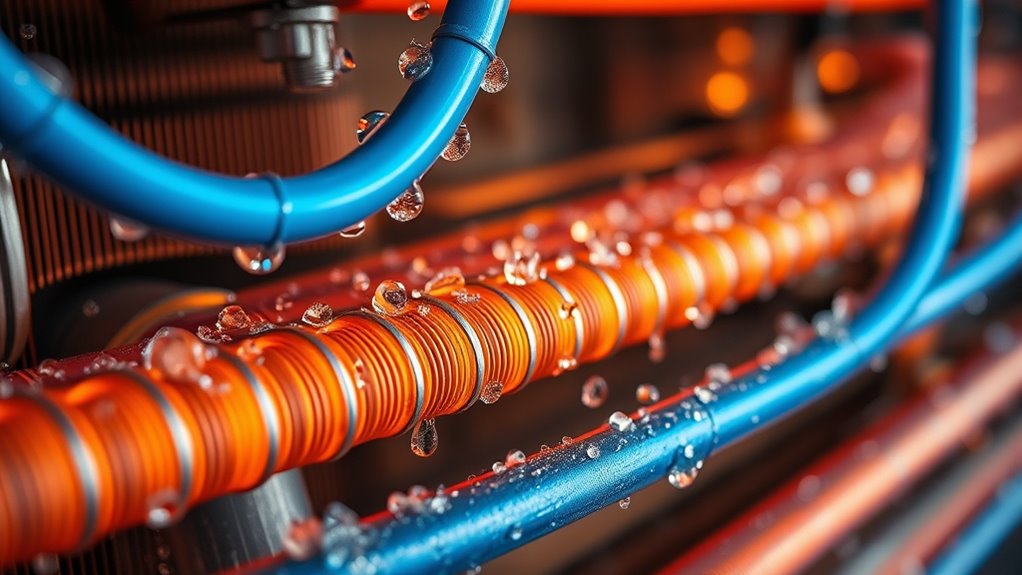
Heat pumps operate based on fundamental thermodynamic principles that enable them to transfer heat efficiently. At the core is the refrigeration cycle, where the refrigerant absorbs heat during evaporation at low pressure and temperature, then releases heat during condensation at high pressure and temperature. These processes follow the laws of thermodynamics, conserving energy while facilitating heat transfer from a cold source to a warm sink. The efficiency of a heat pump is measured by its Coefficient of Performance (COP), which indicates how much heat is moved per unit of work input. A higher COP means better efficiency. The maximum theoretical efficiency aligns with the Carnot cycle, which improves as the temperature difference between the outdoor heat source and indoor heat sink narrows. Additionally, the design of heat pumps often involves heat transfer mechanisms that optimize the flow of thermal energy between components. Understanding the thermodynamic cycles involved allows engineers to enhance performance and reliability of heat pump systems, especially through heat exchanger design improvements that maximize energy transfer. Incorporating advanced component materials can further reduce energy losses and improve overall system efficiency. Furthermore, maintaining proper refrigerant levels is essential for optimal operation and avoiding system failures.
How Heat Is Transferred: Conduction, Convection, and Radiation
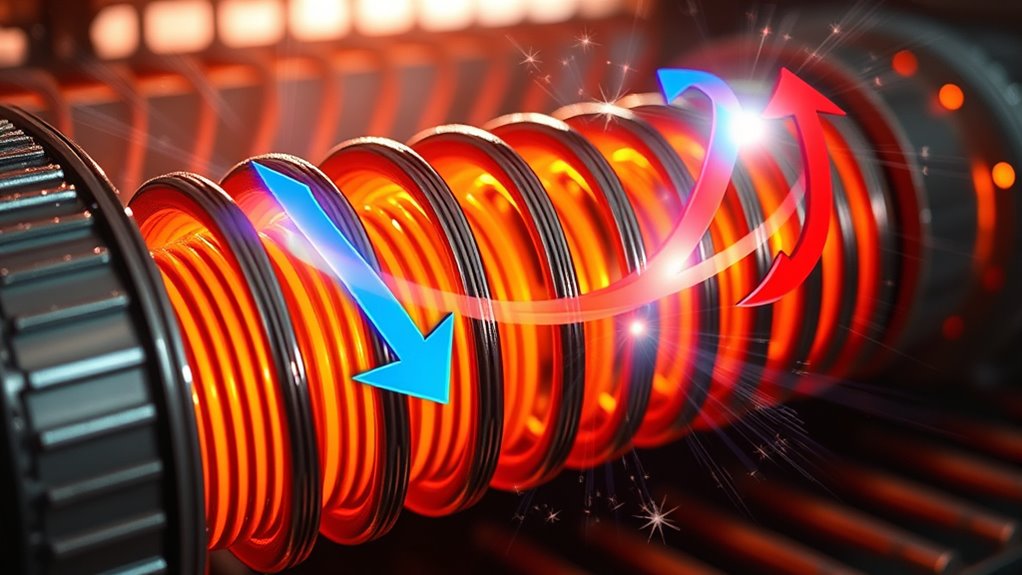
Heat moves through different mechanisms depending on the situation. You’ll see conduction in solid materials, convection in fluids, and radiation across empty spaces or cold environments. Understanding these methods helps you see how heat transfers within heat pump systems and beyond. Additionally, advancements in AI technology, such as generative AI, are beginning to influence the design and optimization of heating systems, leading to more efficient heat transfer processes. Recognizing the types of heat transfer involved can improve system performance and energy efficiency in various applications. Moreover, the efficiency of heat transfer is crucial for reducing energy consumption and environmental impact in modern heating solutions. Being aware of heat transfer mechanisms enables engineers to develop better insulation and energy-saving technologies. As cyber threats become more sophisticated, integrating AI security technologies into control systems can further enhance the safety and reliability of heat pump operations.
Methods of Heat Movement
Understanding how heat moves is essential to grasping how heat pumps operate efficiently. Heat transfer occurs through conduction, convection, and thermal radiation, each playing a crucial role. Conduction transfers heat via direct molecular contact within solids like metal pipes, moving energy from hot to cold areas. Thermal conductivity is a key property that determines how effectively materials transfer heat through conduction. Additionally, the materials used in heat pump systems can significantly influence the overall efficiency of heat transfer. The effectiveness of conduction depends on the material’s properties, which can vary based on composition and structure. Convection involves the movement of fluids—air or water—that carry heat as they circulate, such as warm air rising from a radiator. Fluid movement is essential in transferring heat in many systems and environments. Thermal radiation transfers heat through electromagnetic waves, allowing energy to travel across vacuum gaps, like infrared emitted by a heater. Recognizing these methods helps you see how heat exchange occurs naturally and within systems. Additionally, the efficiency of heat transfer can be influenced by environmental factors, which are important considerations in system design.
Transfer in Different Media
Different media transfer heat through distinct processes: conduction, convection, and radiation. Conduction occurs when thermal energy moves directly between molecules in solids, like the metal pipes in a heat pump. The rate of conduction depends on the material’s thermal conductivity; metals like copper conduct heat efficiently, while insulators like foam do so poorly. Thermal conductivity influences how quickly heat is transferred through different materials, affecting the efficiency of heat transfer in systems. Additionally, material selection plays a crucial role in designing effective heat exchange components, especially when considering cost-effectiveness and durability. Convection involves the movement of fluids—liquids or gases—where heated fluid rises and cooler fluid sinks, enabling heat transfer, as seen in radiator systems. Fluid dynamics principles help explain how convection currents develop and influence heat distribution. Radiation transfers heat through electromagnetic waves, allowing heat to travel through a vacuum, exemplified by sunlight warming the Earth. All three modes—conduction, convection, and radiation—contribute to thermal transfer, shaping how heat moves in different environments within a heat pump system. Additionally, understanding the power consumption of appliances is crucial for optimizing energy efficiency and ensuring safe operation.
Radiation in Cold Environments
In cold environments, radiation becomes an important mode of heat transfer because conduction and convection are limited by low temperatures and minimal fluid movement. You rely on thermal radiation, which travels as electromagnetic waves, to transfer heat even through a vacuum. All objects emit infrared radiation proportional to their temperature, so warmer surfaces radiate more heat. During cold conditions, radiation from warmer surroundings—like indoor spaces or the Sun—can warm objects despite minimal conduction or convection. Surface emissivity influences heat transfer: matte black surfaces emit and absorb more radiation than shiny ones. Recognize that:
- Radiation allows heat transfer across empty space.
- Warmer objects radiate more energy.
- Surfaces with high emissivity are better emitters.
- In cold environments, radiation helps mitigate heat loss.
- Automation technologies are increasingly used to monitor and optimize heat transfer processes in modern heat pump systems.
- Advances in material science are leading to surfaces with tailored emissivity properties that improve heat retention or dissipation.
- The emissivity of surfaces can be engineered to enhance the efficiency of heat transfer in specialized applications. An understanding of the thermal properties of materials is essential for designing effective heat transfer systems. Moreover, understanding the spectral characteristics of emitted radiation can further improve heat management strategies.
The Role of Refrigerants in Heat Transfer Cycles

Refrigerants are key to heat transfer cycles because they change phase to absorb and release heat efficiently. Their thermodynamic properties, like boiling points and pressure, directly influence the cycle’s performance. Additionally, choosing environmentally friendly refrigerants helps minimize the impact on our planet. Embracing creative practice in developing new refrigerants can lead to innovative solutions that balance efficiency and environmental concerns. Understanding the factors affecting refrigerant performance allows engineers to optimize heat pump systems for better energy efficiency and sustainability.
Refrigerant Phase Changes
Have you ever wondered how heat pumps transfer thermal energy so efficiently? The secret lies in refrigerant phase changes. When the refrigerant undergoes evaporation, it absorbs heat from the outside air, transforming from liquid to vapor at constant pressure and temperature. During condensation, it releases heat indoors, changing from vapor back to liquid. These phase changes are vital because they exploit latent heat, enabling effective heat transfer even in cold weather. The refrigerant’s low boiling point allows it to vaporize in chilly conditions, enhancing efficiency. Additionally, the pressure conditions within the system are carefully controlled to facilitate these phase transitions smoothly. Here are four key aspects to spark your understanding:
- Refrigerant’s phase change absorbs and releases heat seamlessly
- Evaporation cools the outside environment while heating the refrigerant
- Condensation heats your living space efficiently
- Latent heat transfer optimizes heat pump performance
Thermodynamic Properties
Understanding the thermodynamic properties of refrigerants is essential for grasping how heat pumps transfer energy efficiently. These properties, such as boiling point, latent heat, and specific heat capacity, determine how well refrigerants perform during the cycle’s phase changes. When refrigerants undergo phase change at specific pressures and temperatures, they absorb or release heat effectively. The pressure-temperature relationship, shown on pressure-enthalpy diagrams, reveals how pressure influences evaporation and condensation temperatures. Modern refrigerants, like tetrafluoroethane, are designed with optimized thermodynamic properties to maximize efficiency and minimize environmental impact. Their ability to change phases at controlled conditions enables smooth heat transfer during evaporation and condensation, making them fundamental to the heat pump’s operation and overall energy performance.
Environmental Impact
The choice of refrigerant directly impacts the environmental footprint of a heat pump’s operation. Modern refrigerants like R410A and R32 have lower ozone depletion potential but still contribute to global warming if leaked. Climate-friendly options, such as HFOs, are developed to reduce this impact further. Your awareness of refrigerant leakage is essential, as escaping refrigerants release greenhouse gases that worsen climate change. Consider these key points:
- Leaking refrigerants directly emit greenhouse gases, increasing your heat pump’s environmental impact.
- New refrigerants aim for low global warming potential without sacrificing performance.
- Proper handling and containment are vital to prevent refrigerant leakage.
- Switching to eco-friendly refrigerants helps reduce your carbon footprint and supports sustainability.
You can make a difference by choosing refrigerants with lower GWP and ensuring proper system maintenance.
The Refrigeration Cycle Explained: Evaporation and Condensation

The refrigeration cycle relies on the refrigerant’s ability to change phases between liquid and vapor, which is essential for heat transfer. During evaporation, the refrigerant absorbs heat at low pressure and temperature, transforming from a liquid into vapor in the outdoor coil. This phase change enables it to take in heat from the outside air or ground. Conversely, during condensation, the high-pressure vapor releases heat as it cools and turns back into a liquid in the indoor coil. Both evaporation and condensation involve latent heat, occurring at constant temperature during each process. The efficiency of heat transfer depends on the refrigerant’s capacity to undergo these phase changes within specific temperature and pressure ranges, ensuring effective transfer of heat from one space to another in the heat pump system.
Impact of Pressure on Evaporation and Boiling Points
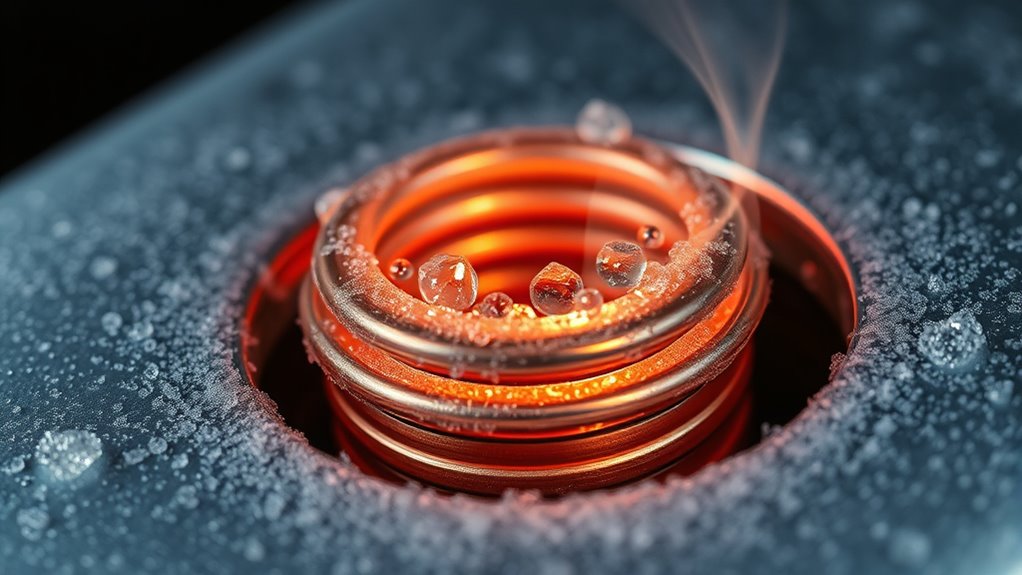
Ever wonder how pressure influences the boiling and evaporation points of a refrigerant? When you increase pressure, you raise the refrigerant’s boiling point, meaning it needs a higher temperature to vaporize. Conversely, lowering pressure decreases the boiling and evaporation points, allowing the refrigerant to vaporize at cooler temperatures. This control over pressure lets you adjust the evaporation temperature to optimize heat absorption from different sources. The pressure-temperature chart clearly shows this relationship, indicating specific boiling points at each pressure level.
Understanding this impact is crucial because:
- Higher pressure means higher boiling point, increasing efficiency.
- Lower pressure enables vaporization at lower temperatures.
- Adjusting pressure improves heat transfer performance.
- Changes in pressure directly influence cycle effectiveness.
How Temperature and Heat Energy Relate in the Cycle

Understanding how temperature and heat energy connect during a heat pump cycle is key to grasping its efficiency. When the refrigerant undergoes phase changes, heat energy shifts without changing temperature, creating plateaus on thermodynamic diagrams. In contrast, within the liquid and vapor phases, heat energy and temperature increase proportionally, highlighting their direct relationship.
Heat Energy-Temperature Link
Heat energy, or enthalpy, in a refrigerant generally increases as temperature rises during the liquid and gas phases, but this relationship changes during phase changes. During evaporation and condensation, heat energy is absorbed or released at a constant temperature, creating a plateau in the heat energy-temperature graph. When the refrigerant enters the evaporator, lowering pressure drops its temperature while it absorbs heat, showing an inverse relationship between pressure and temperature at constant heat energy. During compression, increasing pressure raises the refrigerant’s temperature without notably changing its heat energy, illustrating how pressure directly influences temperature in the gas phase. Recognize that understanding this link helps you see how heat pumps transfer thermal energy efficiently through phase changes and pressure adjustments.
- Feel the power of pressure changing refrigerant temperature.
- Witness phase changes that hold temperature steady despite heat flow.
- Experience how heat energy and temperature dance together in different states.
- See the refrigerant’s journey from low to high temperature through pressure shifts.
Phase Change Dynamics
When refrigerant changes from liquid to vapor or vice versa, heat energy is added or removed at nearly constant temperature, creating a plateau on temperature-heat charts. During the phase change, the refrigerant absorbs heat during evaporation, staying at the boiling point that depends on the system’s pressure, even as its heat energy increases. Conversely, during condensation, the refrigerant releases heat while shifting from vapor back to liquid, maintaining a constant temperature. This process illustrates how phase change governs heat transfer in the cycle. The pressure controls the phase change temperature: higher pressure raises the boiling point, while lower pressure lowers it. This relationship guarantees the refrigerant efficiently absorbs and releases heat, facilitating the heat pump’s operation.
The Compressor’s Function in Raising Temperature and Pressure
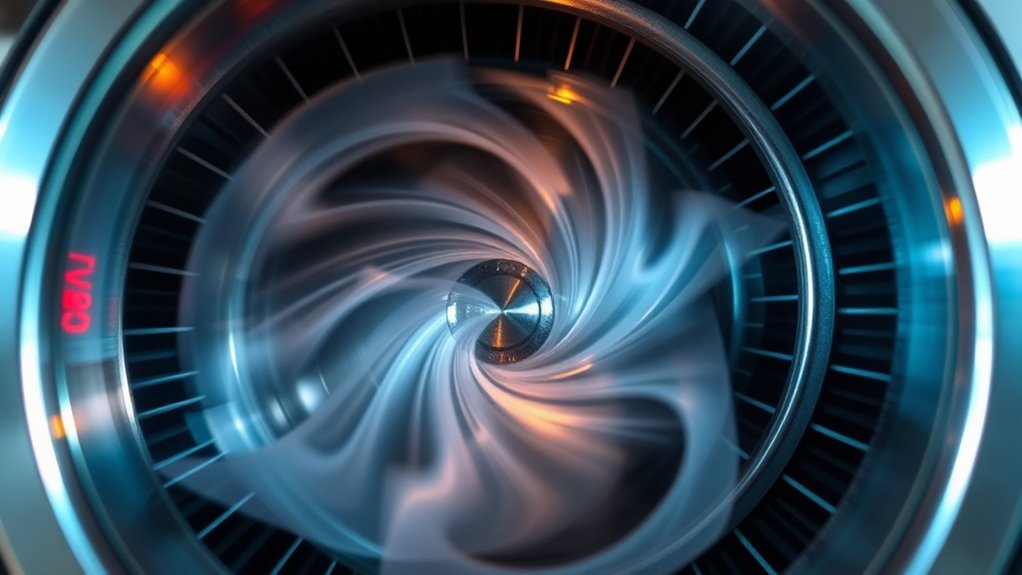
Have you ever wondered how a heat pump boosts heat transfer? It all comes down to the compressor’s role. When the compressor works, it compresses the refrigerant vapor, raising its pressure dramatically. This increase in pressure causes the temperature to rise as well, making the refrigerant hot enough to transfer heat efficiently. Here’s what happens:
- The compressor pulls in cold, low-pressure refrigerant vapor.
- It compresses the vapor, boosting pressure, often up to 333 psi.
- The high-pressure, hot vapor then releases heat as it condenses.
- This process enables heat to transfer from the outside environment to your home.
Without the compressor raising pressure and temperature, the transfer of heat would be impossible against natural gradients, making it essential for heat pump operation.
The Significance of Phase Changes in Heat Transfer Efficiency
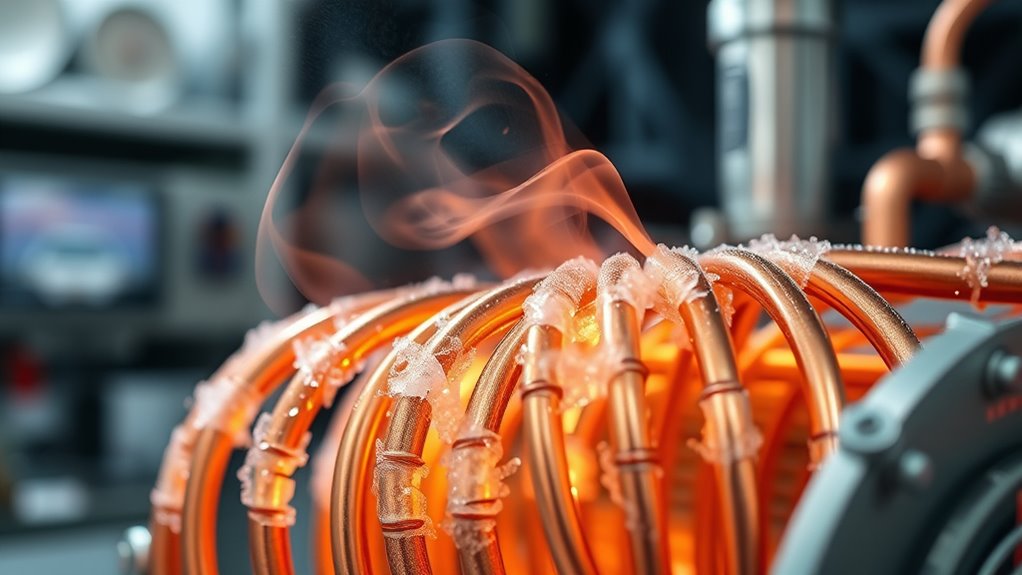
Phase changes like evaporation and condensation play a crucial role in maximizing heat transfer efficiency within heat pumps. During evaporation, the refrigerant absorbs large amounts of latent heat at a constant temperature, enabling effective heat transfer from the outside air. This process allows significant energy transfer with minimal temperature difference, boosting overall efficiency. Similarly, condensation releases latent heat into the indoor environment, efficiently transferring thermal energy without raising the refrigerant’s temperature during the phase change. The energy involved in phase changes is mainly latent heat, which facilitates moving large quantities of heat with less work. Exploiting these phase changes is essential to heat pump operation because they optimize heat transfer, reducing energy consumption while maintaining high performance. This fundamental principle underpins the system’s ability to transfer heat effectively.
Practical Factors Affecting Heat Pump Performance

The performance of a heat pump heavily depends on practical factors that influence its ability to transfer heat efficiently across various conditions. You need to consider how the refrigerant’s properties, like boiling point and heat capacity, affect heat transfer, especially at different temperatures. The outdoor coil’s size and material are vital for maximizing heat absorption in cold weather. Proper installation, insulation, and regular maintenance prevent heat loss and keep efficiency high. Additionally, optimizing the heat exchanger design improves performance in low-temperature environments. Here are key factors to keep in mind:
- The refrigerant’s thermodynamic properties
- The outdoor coil’s size and material
- Accurate system installation and insulation
- Advanced compressor and cycle design for colder temperatures
Visualizing Heat Transfer With Charts and Diagrams

Ever wondered how engineers visualize the complex process of heat transfer in a heat pump? They use pressure-enthalpy diagrams to map the refrigerant cycle, showing how pressure, temperature, and heat transfer relate during phase changes. These charts highlight constant-temperature plateaus during evaporation and condensation, making it easier to see where heat transfer occurs. Logarithmic pressure ratios help illustrate how pressure affects boiling and condensing points of the refrigerant. Visual diagrams also map each component’s role—compressor, evaporator, condenser, and expansion valve—through different thermodynamic states. By examining these charts, you can see how adjusting pressure and temperature conditions optimize heat transfer efficiency, providing a clear picture of how the entire heat pump cycle functions seamlessly.
Frequently Asked Questions
How Does Heat Be Transferred in a Heat Pump?
You might wonder how heat moves in a heat pump. It works by using a refrigerant that absorbs heat from outside, vaporizes, and then gets compressed to increase its temperature. This hot vapor releases heat inside as it condenses back into a liquid. The cycle repeats, transferring warmth from outside to inside efficiently. This process allows your heat pump to provide heating by moving heat rather than generating it.
What Is the Physics Behind a Heat Pump?
You might think a heat pump just moves heat, but the physics behind it is fascinating. It uses thermodynamics principles, where refrigerant absorbs heat during evaporation at low pressure and releases it during condensation at high pressure. By compressing and expanding the refrigerant, it transfers thermal energy efficiently, even from cold outdoor air to warm indoor spaces. This cycle relies on phase changes and pressure control, making heat transfer possible without directly generating heat.
How Does Heat Transfer Work in Physics?
Heat transfer in physics involves moving thermal energy from a warmer to a cooler object, driven by temperature differences. You can think of it happening through conduction, where energy passes directly through materials; convection, where fluid movement carries heat; and radiation, where electromagnetic waves transfer energy. The rate depends on factors like temperature difference, surface area, material properties, and mechanisms like fans or radiators that enhance the process.
What Is the Equation for the Heat Transfer of a Heat Pump?
You might think heat transfer in a heat pump is complex, but it follows a simple principle: the heat delivered to your space (Q_hot) equals the heat extracted from outside (Q_cold) plus the work done (W). The basic equation is Q_hot = Q_cold + W. This shows how the pump moves heat efficiently, with the work input driving the transfer from cold to hot areas.
Conclusion
Understanding heat transfer in heat pumps reveals how efficiently they work. Did you know that modern heat pumps can deliver up to three times more heat energy than the electrical energy they consume? This impressive efficiency stems from principles like phase changes and pressure manipulation. By mastering these concepts, you can better appreciate how heat pumps provide sustainable, cost-effective heating solutions, making them a smart choice for energy-conscious homes and businesses alike.
